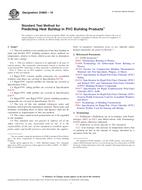We need your consent to use the individual data so that you can see information about your interests, among other things. Click "OK" to give your consent.
ASTM D788-14
Standard Classification System for Poly(Methyl Methacrylate) (PMMA) Molding and Extrusion Compounds
STANDARD published on 1.8.2014
The information about the standard:
Designation standards: ASTM D788-14
Note: WITHDRAWN
Publication date standards: 1.8.2014
SKU: NS-39228
The number of pages: 6
Approximate weight : 18 g (0.04 lbs)
Country: American technical standard
Category: Technical standards ASTM
The category - similar standards:
Annotation of standard text ASTM D788-14 :
Keywords:
acrylic, acrylic plastic, acrylic resins, clear weatherable plastics, line callout, plastic, plastic materials, PMMA, poly(methyl methacrylate), recycled, transparent plastics, ICS Number Code 83.140.99 (Other rubber and plastic products)
Additional information
| 1. Scope | ||||||||||||||||||||||||||||||||||||||||
|
1.1 The purpose of this classification system is to provide a method of adequately identifying PMMA materials using a system consistent with that of Classification System D4000. It further provides a means for specifying these materials by the use of a simple line callout designation. 1.2 This classification system covers poly(methyl methacrylate) molding and extrusion compounds. These compounds are polymers based on methyl methacrylate, and at least 70 % of the polymer shall be polymerized from methyl methacrylate. 1.3 The properties in this classification system are those required to identify the compositions covered. Other requirements necessary to identify particular characteristics important to specific applications shall be described by using the suffixes as given in Section 5. 1.4 Acrylic molding and extrusion compounds are used frequently in applications where extreme clarity and the ability to retain that clarity and color under severe weathering and other environmental exposures are of primary significance. While the test specimen properties of this document extend to the evaluation of nonvirgin materials, the user must take precautions to ensure that parts made from these materials meet the desired end-use requirements. Accordingly, this specification allows for the use of those acrylic plastic materials that can be recycled, reconstituted, and reground provided the following: 1.4.1 The requirements as stated in this specification are met, 1.4.2 The material has not been modified in any way to alter its conformance to food contact regulations or similar requirements, and 1.4.3 The requirements of the particular end-use application are met. 1.5 This classification system and subsequent line callout (specification) are not intended for the selection of materials, but only as a means to call out plastic materials to be used for the manufacture of parts. The selection of these materials is to be made by personnel with expertise in the plastics field in which the environment, inherent properties of the materials, performance of the parts, part design, manufacturing process, and economics are considered. Note 1: This classification system is similar to ISO
8257-1:1987 in title only. The technical content is significantly
different.
1.6 The values stated in SI units are to be regarded as standard. 1.7 This standard does not purport to address all of the safety concerns, if any, associated with its use. It is the responsibility of the user of this standard to establish appropriate safety and health practices and determine the applicability of regulatory limitations prior to use. |
||||||||||||||||||||||||||||||||||||||||
| 2. Referenced Documents | ||||||||||||||||||||||||||||||||||||||||
|
Similar standards:
Historical
1.9.2011
Historical
1.3.2009
Historical
1.8.2014
Historical
1.11.2010
Historical
1.12.2011
Historical
1.3.2007
We recommend:
Technical standards updating
Do you want to make sure you use only the valid technical standards?
We can offer you a solution which will provide you a monthly overview concerning the updating of standards which you use.
Would you like to know more? Look at this page.



 ASTM D4020-11
ASTM D4020-11 ASTM D4726-09
ASTM D4726-09 ASTM D4745-14
ASTM D4745-14 ASTM D4803-10
ASTM D4803-10 ASTM D4812-11
ASTM D4812-11 ASTM D5203-07
ASTM D5203-07
 Cookies
Cookies
